After exploring the amazing Amazon for several days, we arrived late the previous night in the colonial city of Arequipa in southern Peru. The country's second-largest city was the classic starting point for touring the Colca Canyon, the 'Grand Canyon of South America' which we would be heading to the next day.
As Arequipa was built almost entirely from sillar, a white volcanic rock, the city has earned its nickname of la ciudad blanca or the White City.
These cacti acted as a fence, something we'd never seen before.
As we walked into the city's historic center, we noticed several taxi drivers washing their cars with water from the water channels next to the sidewalk. What an inventive way to reuse and recycle!
As Arequipa is guarded by not one but three dramatic volcanoes: Misti, Mt. Chachani and Pichu Pichu, the city had a seismically precarious setting with earthquakes regularly wracking the region, the last big one causing significant damage in 2001. We were alarmed to discover that there was another, luckily minor one, early last month.
Funnily enough, it seemed that virtually all the taxis in the White City were also white.
Most of the sillar found in the Arequipa Valley was produced by eruptions from Mt. Chachani. It was first used during the colonial period; there is no evidence of its having been employed in pre-Hispanic times.
The lovely view of the white sillar cathedral made us wonder what other beautiful sights were up ahead beyond the pedestrian street.
The vendor sold small rolls when not otherwise preoccupied with the cell phone.
I felt like I should be a royal personage entering the cathedral through the archway.
Your smile for the day!
Southeast of the plaza was the elaborate carved facade of the Iglesia de la Compania de Jesus, built to house the Jesuits and provide them with a spiritual center in the 17th century.
The Chapel of San Ignacio, located inside the church, was adorned with a collection of exotic murals depicting colorful birds and animals.
A variety of gold and silver religious objects were ensconced in the beautiful chapel.
The elaborately carved wooden pulpit, held aloft by a devil with a serpent's tail, was made in France!
The altar and columns were made of Carrara marble from northern Italy. Throughout the Cathedral, I was taken with the contrast of its white marble and the pale yellow paint - my favorite color - but not a shade I have seen used in other churches. For me, it was impossible not to feel immediately at peace seeing the calming combination.
It is the only organ in South America that has a Chair Organ place behind the player's back.
The information panel indicted the miter headdress, used exclusively for bishops, cardinals and the Pope, represented their authority.
She pointed out the ethereal image of 5825 m-high Misti was the only still active one.
The bells in the clock tower rang every 15 minutes. The clock was made in England. The other set of bells only ring at Christmas and Easter.
A view overlooking Plaza de Armas: I looked for Steven knowing he was somewhere down below but, alas, I couldn't find him!
Steven looked right at home with the locals!
The bank also had a small museum and gallery inside which was where we headed.
One room presented a group of oil paintings that highlighted essential aspects of Peruvian men: their character, their struggle, their daily lives. They allowed us to understand the huge contribution of Arequipean artists to the history of painting in Peru.
Two of the four paintings by the 20th century Arequipa-native painter Teodoro Nunez Ureta showed daily street and market life; the others referred to activities of people from the coast.
Formerly known as the Casona Iriberry, the 18th century building showcased an exhibition of local artists.
Steven and I were both drawn to this painting of Pisac, the town we had visited near Cusco where we enjoyed the wonderful market and Mass celebrated in Quechua.
The oil painting of the Sacred Valley was another special one.
One of the charming stone patios was the ideal place for budding artiists.
These had to be the most unusual bathroom 'signs' we had ever seen!
Even the local McDonald's, barely thirty steps from the Cathedral, looked in keeping with the rest of the White City!
The church is the center of attention every December 8th during the Feast of the Immaculate Conception. Then, a fairy tale coach topped with the image of the Virgin Mary surrounded by angels and saints, usually stored in the small Chapel of the Sorrowful Virgin, is paraded through the city's historic center. The main altar had a solid silver facade.
A nighttime look at the Santa Catalina Monastery:
As Arequipa was built almost entirely from sillar, a white volcanic rock, the city has earned its nickname of la ciudad blanca or the White City.
These cacti acted as a fence, something we'd never seen before.
As we walked into the city's historic center, we noticed several taxi drivers washing their cars with water from the water channels next to the sidewalk. What an inventive way to reuse and recycle!
As Arequipa is guarded by not one but three dramatic volcanoes: Misti, Mt. Chachani and Pichu Pichu, the city had a seismically precarious setting with earthquakes regularly wracking the region, the last big one causing significant damage in 2001. We were alarmed to discover that there was another, luckily minor one, early last month.
The attractive entrance to the Grand Park, visible from the bridge as we entered the city center.
Most of the sillar found in the Arequipa Valley was produced by eruptions from Mt. Chachani. It was first used during the colonial period; there is no evidence of its having been employed in pre-Hispanic times.
The vendor sold small rolls when not otherwise preoccupied with the cell phone.
I felt like I should be a royal personage entering the cathedral through the archway.
Your smile for the day!
We had to agree with those that said the city's lively Plaza de Armas, the heart of Arequipa, was one of the most beautiful in Peru. Bordered by the impressive two-towered cathedral, two-story arcades containing restaurants and shops graced the other three sides of the plaza.
The square was exquisite with its palm trees, old gas lamps and a white stone fountain nestled in an English-style garden. I read that Arequipeños congregated there for political rallies, protests and fiestas in addition to its being clearly a hub of local life.
The statue atop the fountain was of Tuturuto who represented a 16th century soldier who informed citizens of news and events. Sounded like a town crier.
The carved portals had Moorish touches.Southeast of the plaza was the elaborate carved facade of the Iglesia de la Compania de Jesus, built to house the Jesuits and provide them with a spiritual center in the 17th century.
As the church was due to close shortly, we could only spend a short while admiring its carved wooden altars with gold leaf,
It was interesting to see native Inca symbolism incorporated in the facades and paintings in the church.
The elaborately carved pulpit:
The Chapel of San Ignacio, located inside the church, was adorned with a collection of exotic murals depicting colorful birds and animals.
A variety of gold and silver religious objects were ensconced in the beautiful chapel.
The stunning murals of warriors and angels mingled with tropical flowers, fruit and birds from the Amazon area.
The cloisters, added in the 18th century, had a wonderful selection of high-end shops selling alpaca clothing.
We retraced our steps across the plaza to the massive Cathedral San Pedro, regarded as the most important Neo-Classical religious building in Peru. Flanked by two arches, it is the only cathedral in Peru that stretches the entire length of a plaza.
Steven decided to relax in the plaza while I took a tour of the Cathedral and its museum. It was originally constructed in 1621 before being damaged by a series of earthquakes and fire. It was rebuilt in 1868.
Our guide told us the twelve columns represented the 12 apostles.
Additional, equally stunning chapels:
The Cathedral of Arequipa once had three organs before one was destroyed by the 1784 earthquake and two in the fire in 1844. The current organ was fabricated in the Loret workshops in Belgium and delivered to Arequipa in 1854. It, too, had to be restored when it suffered damage in the devastating earthquake of 2001.
I was so glad I had chosen to take the tour because that was my only opportunity to view the exquisite Cathedral.
The museum's documents room contained manuscripts, bibles and parish record books from the 17th century.
I don't know what word to describe the embroidery on the cape other than stunning.
The Pluvial Cape was used by the Monsignor during funerals and funeral rites.
When the guide took us to the roof, we had panoramic views of the three volcanoes looming above the city. How lucky I was that the day was clear so I had such lovely views of the towering volcanoes.
As the Cathedral was closed when we were there, I noticed one of the priests was hearing confessions out front - another 'first' for me.
The second archway on the far side of the Cathedral:Steven looked right at home with the locals!
Walking through the streets of UNESCO-listed Arequipa of mostly one single-story buildings with carved wooden doors, French windows with ornate grilles and high-ceilinged rooms clustered around spacious central patios was just lovely.
You can see how easy it was to be captivated by arresting Arequipa with its rough finished white stone colonial buildings!
One of the best was Casa Ricketts that had been built as a seminary in 1738 and was now the Banco Continental. The frieze above the door depicted medallions of Jesus, Joseph and Mary.
The house, which dated from the 18th century, was bought in 1974 by Banco Continental as they "understood the need for private enterprises to contribute to the recovery of the country's monumental heritage."
Imagine being able to do your financial transactions there rather than at the local Chase Bank!
One room presented a group of oil paintings that highlighted essential aspects of Peruvian men: their character, their struggle, their daily lives. They allowed us to understand the huge contribution of Arequipean artists to the history of painting in Peru.
Two of the four paintings by the 20th century Arequipa-native painter Teodoro Nunez Ureta showed daily street and market life; the others referred to activities of people from the coast.
Details from the home's colonial past:
A few steps away was the equally charming Complejo Cultural Chaves la Rosa or Cultural Complex that was part of the University of San Augustin.
The oil painting of the Sacred Valley was another special one.
One of the charming stone patios was the ideal place for budding artiists.
These had to be the most unusual bathroom 'signs' we had ever seen!
The center's Cafe Lautrec:
We were amazed at how talented so many of the Cultural Center's young artists were and were glad we had stopped by to view their work and admire another of the city's architectural gems.
We walked around the entire Plaza de Armas enjoying the coolness of its arcades.
Even the local McDonald's, barely thirty steps from the Cathedral, looked in keeping with the rest of the White City!
The entrance way to the Interbank was one of the most impressive we'd ever seen.
Even the Tribunal Superior Policia Militar building was attractive.
We spent the next few hours at one of the largest religious institutions we've seen anywhere in the world, the Monasterio de Santa Catalina. As I felt it deserved its own post, the following is a continuation of a special day in one of Peru's most beautiful cities.
Close to Santa Catalina was the 16th century Iglesia de San Francisco, which, despite being battered by numerous earthquakes, was still standing, albeit with a few scars. The church featured an unusual brick entrance way.The church is the center of attention every December 8th during the Feast of the Immaculate Conception. Then, a fairy tale coach topped with the image of the Virgin Mary surrounded by angels and saints, usually stored in the small Chapel of the Sorrowful Virgin, is paraded through the city's historic center. The main altar had a solid silver facade.
People enjoyed the adjacent Plaza de San Francisco in the waning hours of the afternoon.
Steven and I were incredibly fortunate that Adrian, the cousin of Gloria, my wonderful Colombian sister-in-law, welcomed us to the Colombian restaurant he and his Peruvian wife owned in Arequipa. In all of our overseas travels over the last five years, we've never been lucky enough to meet family or friends.
Adrian had also kindly picked us up late the night before when we arrived from the Amazon via flights from Cusco and Lima. I hope we can extend a warm Colorado welcome to him and his growing family in the not too distant future.A nighttime look at the Santa Catalina Monastery:
Next post: A visit from earlier in the day to the Santa Catalina Monastery, a city within a city.
Posted on February 3rd, 2018, from Littleton, Colorado.






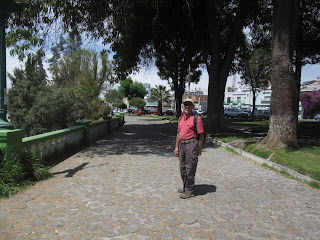



































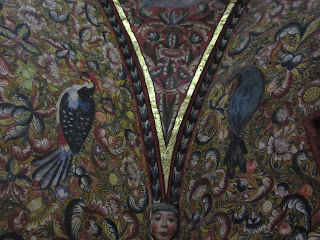
















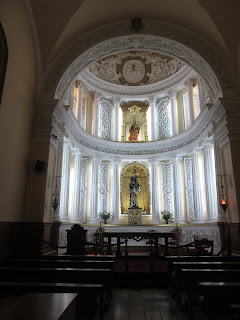















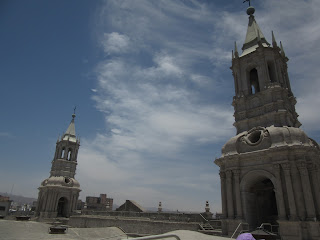



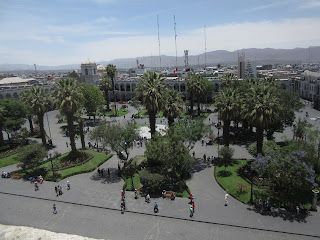

























































hello Annie and Steven, It´s nice to have news from you again. Congratulations for your post, it is very interesting and helpful for people planning to travel abroad, in this case Arequipa. The pictures and comments about the interesting places in Arequipa are very well done and precise. It requires a lot of long work hours to do things like this, and the nicest thing about it is that you do it only for the sake to help others. I will show this to friends, relatives and acquaintances who want to come to visit Peru so they can have a good Idea what places to visit and what to do during their usually thight schedules.Thanks for posting a picture of us while you were here. I am sure you had a wonderful time here in Peru, and hope you liked the arepas. I hope to share nice moments with you again. Thanks!! Luis Adrian
ReplyDeleteLuis Adrian,
DeleteThe kind words you wrote were music to my ears - thank you! I always hope to bring a city or place we visit 'alive' to those reading the post so they get a sense of our experiences when traveling. The post on your adopted city of Arequipa was so easy to write as it was so incredibly charming and beautiful. Our short time there was made even more special by meeting you, an extended member of my family, and being served such delicious food in your restaurant, Luis Adrian. I hope our paths will cross again in the future.
Hi my Dear Annie,
ReplyDeleteThe city looks very interesting, a lot of history, spectacular architecture, everything looks monochromatic.
I am happy that you have met my nephew Luis Adrian, the son of one of my brothers. Paul and I are thinking of going to visit Luis Adrian in the near future. I hope we can visit some of the sites you visited in Peru.
Thank you for sharing your incredible experience during your travels.
With a lot of love, (con mucho amor)
Gloria
Dear Gloria,
ReplyDeleteI can't imagine that you and Paul wouldn't have a spectacular time visiting so much of Peru just as we did. There were so many fantastic highlights - Machu Picchu and the Sacred Valley, of course, but also the Amazon River Basin, the pretty White City of Arequipa where we had the pleasure of meeting your charming nephew, Luis Adrian, and so much more!
Con mucho amor para ti!